This Ultimate Guide to Frontier People Groups contains everything you need to know about frontier peoples – what they are, where they are, how many there are, and how you can reach them!
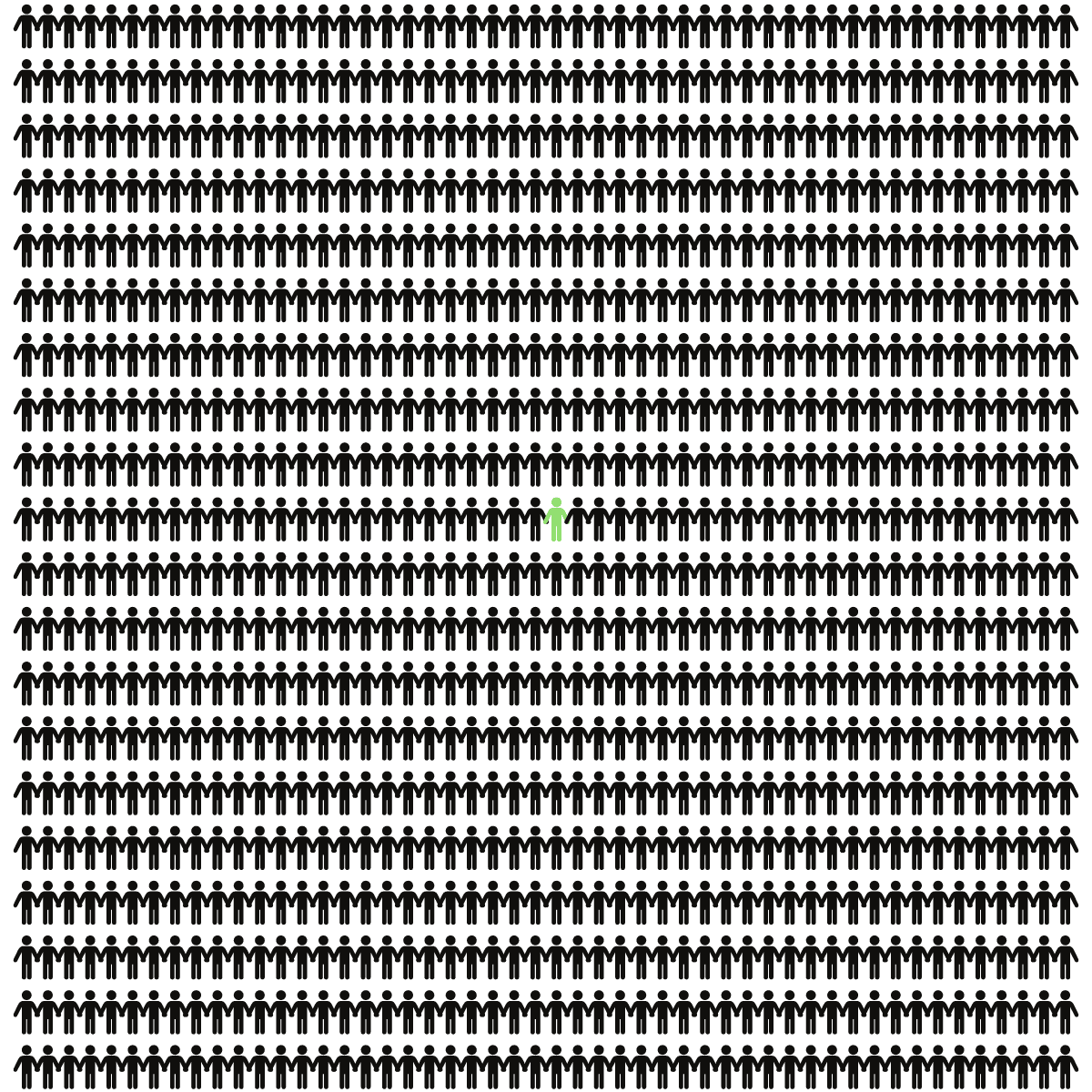
What are frontier people groups? (FPG)
In Christian missiology, a frontier people group is an unreached people group that has 0.1% or fewer followers of Jesus and no confirmed, sustained church planting movement among them.
Said another way, for every 10,000 people in a people group, frontier people groups have 10 or fewer Christians!
To put that into perspective, let’s pretend the Dallas-Fort Worth Metroplex was one giant frontier people group. Pew Research estimates that the Dallas-Fort Worth metroplex is 59% Protestant.[source] With a population of 7.5 million people, that means that DFW has an estimated 4,425,000 Protestants. If DFW was one giant frontier people group, it would have fewer than 7,500 Protestant Christians!
Where are frontier people groups located?
The vast majority (90%) of all frontier peoples are located in what is known as the 10/40 Window. Further, 98% of the frontier people groups with over 1 million in population are located in the 10/40 Window.
India alone has over 1/3 of all FPGs, while other Muslim-majority countries in the 10/40 Window make up most of the remainder.

Why are they significant?
Frontier people groups are significant because there is very little church foundation within the people group for outside missionaries to build on, so FPGs still require pioneer cross-cultural missionaries.
People groups that are more than 0.1% evangelical Christian have churches that outside workers can work with to help the gospel spread within that people group.
Within non-frontier unreached people groups, missionaries ask the question, “How can we help the existing church spread the gospel within their people group?”
But missionaries working among frontier peoples are asking the question, “How will we see our first believers come to faith?
Visualization
It can difficult for people outside of the 10/40 Window to visualize what it’s like to live among a frontier people group.
When a missionary working among a frontier people group tells an American about the great gospel needs of their people group or place, a common response is, “You don’t need to go there, America’s got enough problems of its own!”
And yes, this is partially true… America does have its problems.
But people living in the 10/40 Window often have similar societal issues (racial inequality, income gap, violence, broken families etc) and they don’t have access to the gospel to help them navigate those issues.
Even though Christianity has been on the decline in the United States, 1/3 of people in the American people group identify as evangelical Christians.
Here is what that looks like for 1,000 people.
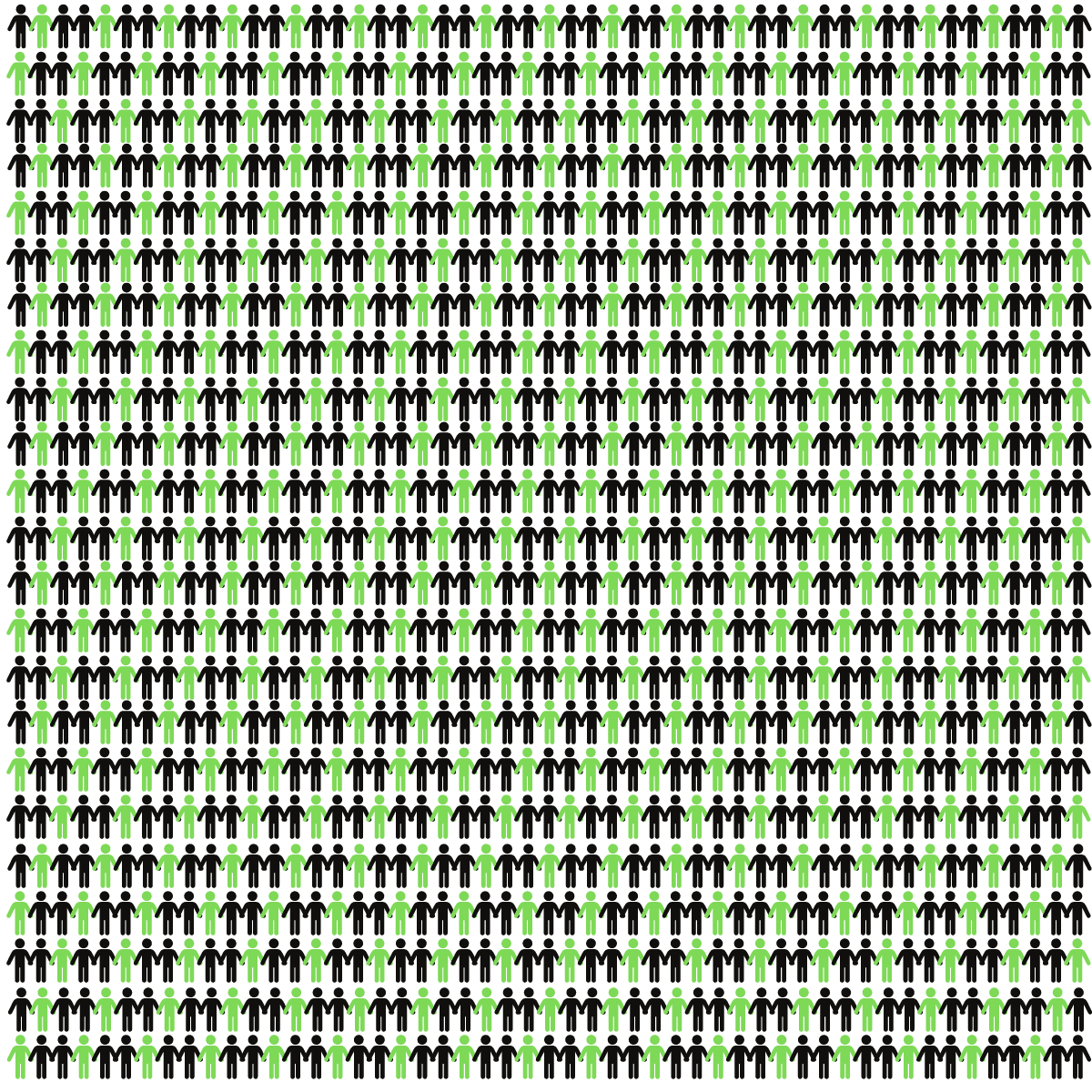
Here’s what 1,000 people look like in an unreached people group.

But those 20 Christians aren’t typically evenly distributed throughout their unreached people group. You often have small house churches with some individual Christians who need to find a church fellowship as shown below.

That’s actually the maximum number of Christians allowed by the definition to be considered an unreached people group. An unreached people group has 20 or fewer evangelical Christians for every 1,000 people.
Which means an unreached people group could have 1 Christian for every 1,000 people.
This is what that 1 Christian looks like among 1,000 people.

A frontier people group has 999 lost souls and one believer with no community.
Again, this is the maximum number of Christians allowed to be considered a frontier people group. A frontier people group has 1 or fewer evangelical Christians for every 1,000 people.
The Turk people group in Turkey has 1 believer for every 10,000 people.
Here’s what that looks like.

Imagine you were born a Turk. Imagine you were any one of those 9,999 lost souls without hope of an eternity spent with God.
Who would you hear the gospel from?
It wouldn’t come from your family, friends, or coworkers. None of them are believers. None of them know Jesus as their Savior.
It would have to come from someone who is willing to cross cultures and share the Gospel with you.
Before you get completely discouraged about the plight of people living among frontier peoples, be sure to read The Progress section.
Challenges
Non-Existent Christian Community
Another key distinction of frontier people groups is that Christians within them often don’t have any church community from within their people group. What often happens with new believers is that well-meaning missionaries extract them from their natural community and encourage them to join existing church communities of foreign cultures.
This extraction often breaks the relationship between the new believer and his community and causes the remaining 999 to reject Christianity as a foreign religion.
A Matter of Identity
97% of the 2 billion people living in frontier people groups follow Islam or Hinduism.
Why is that?
It’s likely a matter of identity.
People within Muslim people groups and Hindu people groups often see their group identity tied to their religion.
People from Muslim people groups will often say things like, “To be Malay is to be Muslim.”
According to Pew Research, many Indians see religious identity, national identity, and group identity all closely linked.
This way of thinking isn’t completely unique to Islam or Hinduism. “To be Burmese is to be Buddhist” is also a commonly used phrase, and accordingly, the Burmese are 0.08% Christian.
But as you will see in the next section below, this way of tying group identity to religious identity is very prevalent among Muslim people groups and Hindu people groups.
By Population
According to Joshua Project, frontier people groups can range in population from a few dozen people all the way up to the Shaikh of Bangladesh, which has 130 million people.
Some mission strategists emphasize prayer for and pursuit of movements among the largest frontier peoples because of the influence these large groups have on neighboring groups, and the potential for movements to spread to them.
The subsections below give information about the number, the primary religion, and the location of frontier people groups at different population levels.
Over 25,000,000
There are currently 10 frontier people groups (FPGs) with over 25 million people. Six of the top 10 largest FPGs are Muslim and four are Hindu.
None of the FPGs over 25 million people are Tribal, Unreligious, or Buddhist.

The map below shows that all 10 of the frontier peoples with over 25 million people are in the 10/40 Window. Five of the top 10 largest unreached people groups are located in India, while Bangladesh, Turkey, Algeria, Uzbekistan and Pakistan each have one.

Want to learn more about and pray for the 10 largest frontier peoples?
Sign up to receive once-a-week prayer profiles for the 10 largest frontier peoples using the button below.

“Slow drip” your learning and prayers for the 10 largest frontier people groups in the world with Pray1040! Receive a new prayer profile each week covering the 10 frontier people groups that have more than 25 million people. Each profile takes 5-10 minutes to pray through.
Over 10,000,000
There are currently 38 frontier people groups (FPGs) with over 10 million people. Of these 38 FPGs, 23 are Muslim and 15 are Hindu.
None of the FPGs over 10 million people are Tribal, Unreligious, or Buddhist.
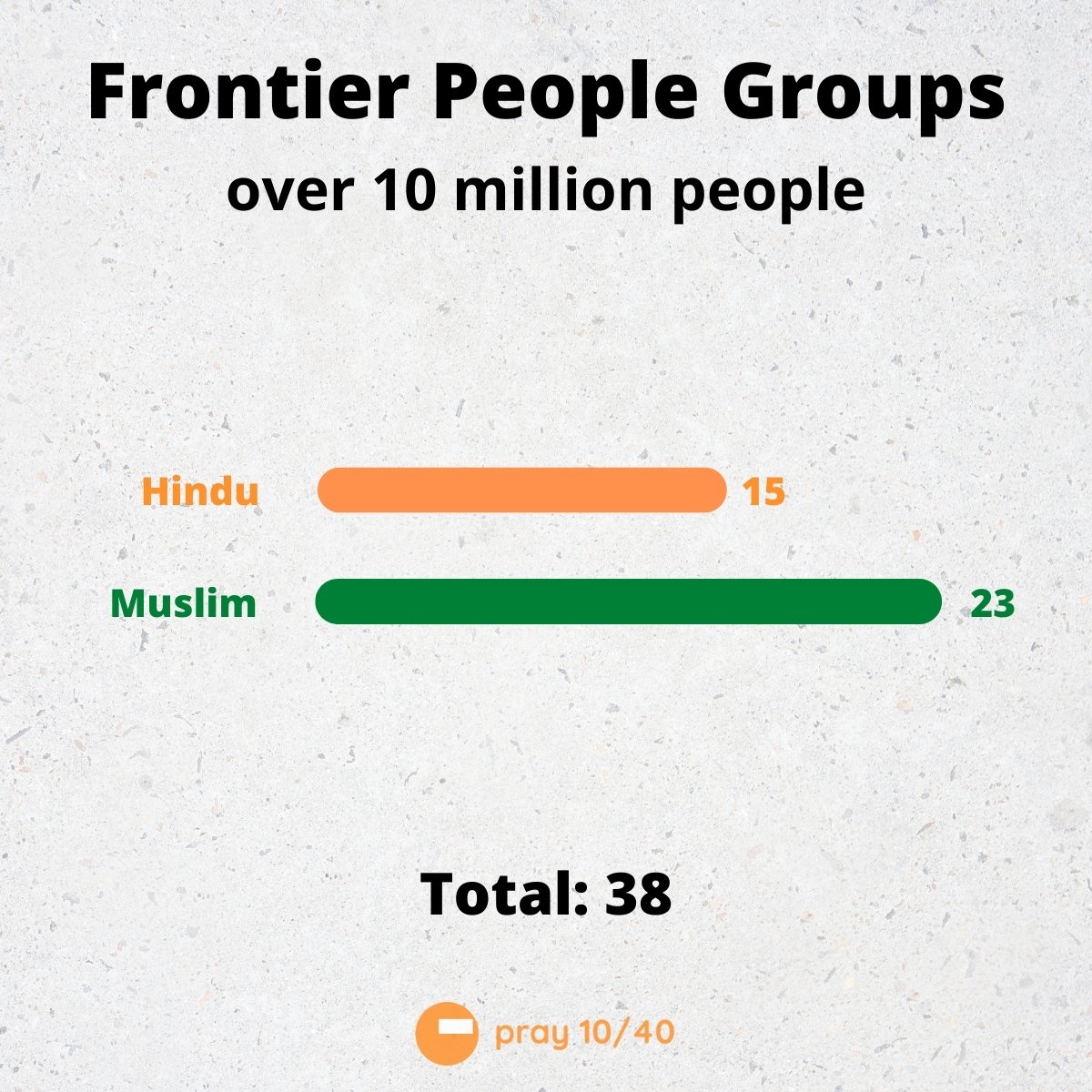
As shown in the map below, all 38 frontier people groups over 10,000,000 people are in the 10/40 Window.

India has 18 of the 38 frontier peoples with over 10 million people. Pakistan has 4 while Saudi Arabia, China, Bangladesh, and Afghanistan each have two. Eight other countries have one.

Want to learn more about and pray for the 38 frontier peoples with over 10 million people?
Sign up to receive once-a-week prayer profiles for the 10 largest frontier peoples using the button below.

“Slow drip” your learning and prayers for the 38 largest frontier people groups in the world with Pray1040! Receive a new prayer profile each week covering the 38 frontier people groups that have more than 10 million people. Each profile takes 5-10 minutes to pray through.
Over 1,000,000
There are currently 291 frontier people groups (FPGs) with over 1 million people. Of these 291 FPGs, 151 are Muslim, 131 are Hindu, 3 are Tribal, 3 are Unreligious, and 3 are Buddhist.

285 of the 291 frontier people groups over 1,000,000 people are in the 10/40 Window.
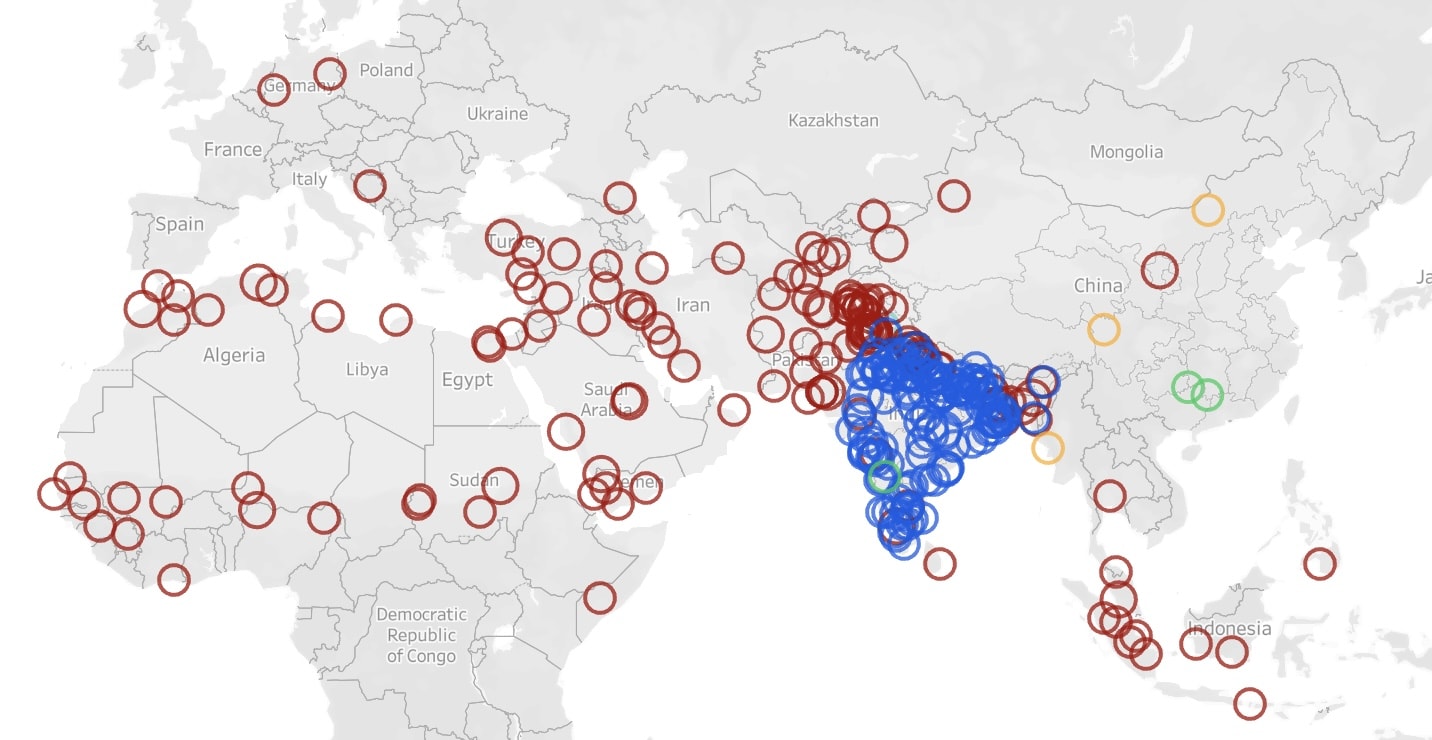
India has 154, Pakistan has 39, and all other countries have 10 or fewer.
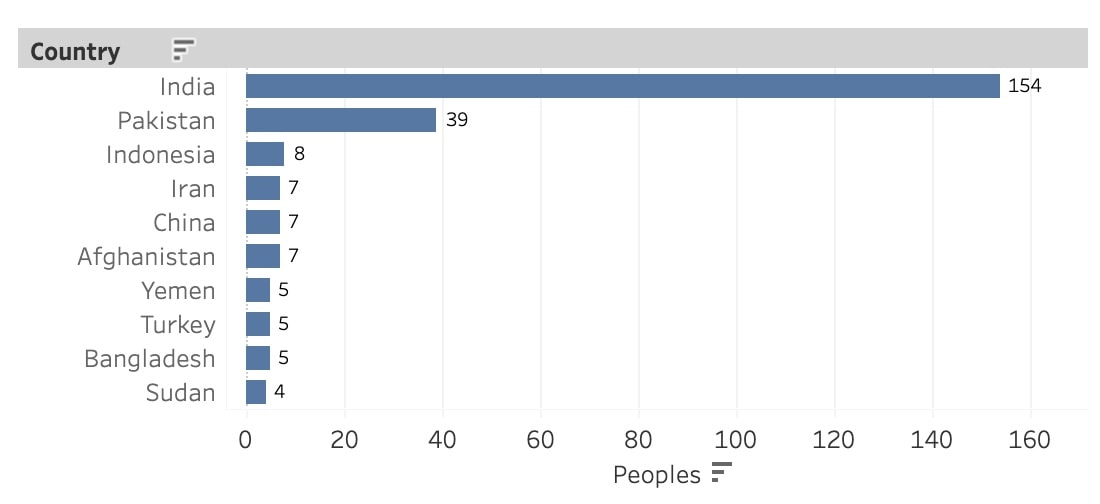
Only 6 of the 291 frontier people groups with over 1 million people are outside of the 10/40 Window.
All six of these groups are Muslim.
Below is a list of these six groups:
- Bosniaks of Bosnia-Herzegovina
- Nohchi Chechens of Russia
- Hausa of Cote d’Ivoire
- Kazakhs of Gemany
- Mahuindanao of Philippines
- Turks of Germany
All Populations
There are currently 4,971 frontier people groups (FPGs) in the world. Of these 4,791 FPGs, 2,480 are Muslim, 1,747 are Hindu, 222 are Buddhist, 114 are Tribal, and 2 are Unreligious.

Below is a map of all frontier people groups in the world color coded by religion.
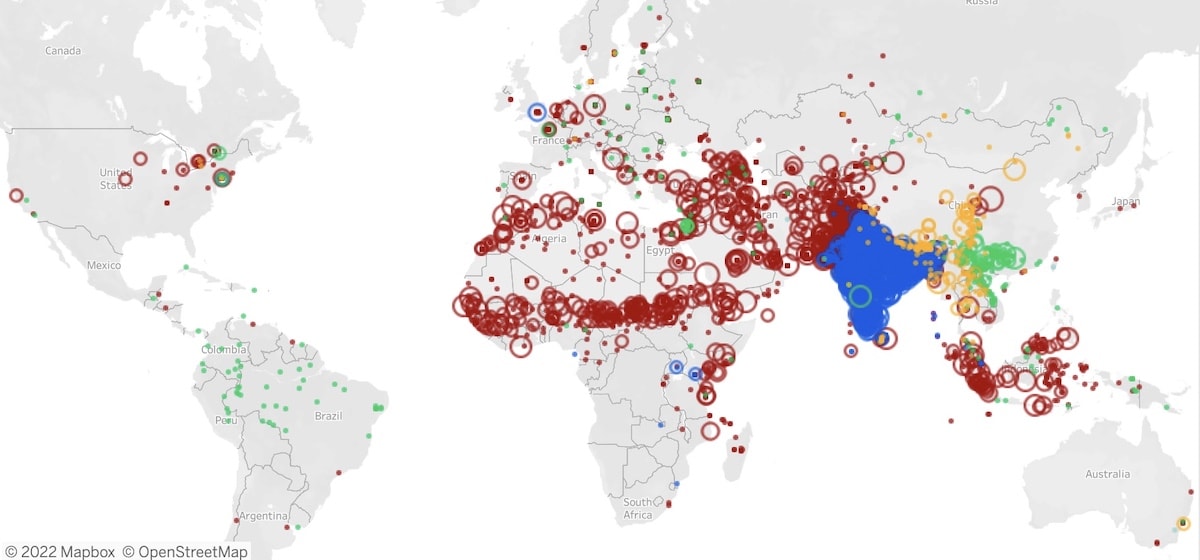
By Language
With the majority of frontier people groups (FPGs) following Islam, you might expect Arabic to be spoken by the most number of frontier peoples.
But Arabic doesn’t even crack the top 10!
All of the top 10 languages spoken by the most number of frontier people groups are primarily spoken in south Asia.
Hindu and Urdu and linguistically very similar with different religious terms for Hinduism (Hindi) and Islam (Urdu).
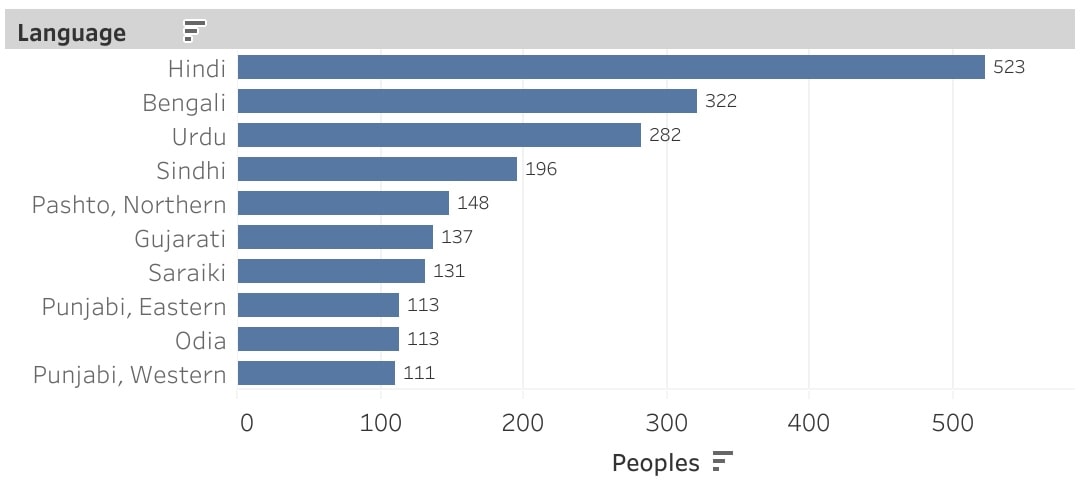
When the top 10 languages spoken by frontier people groups are broken down by population, Turkish and Algerian Arabic make the top 10.
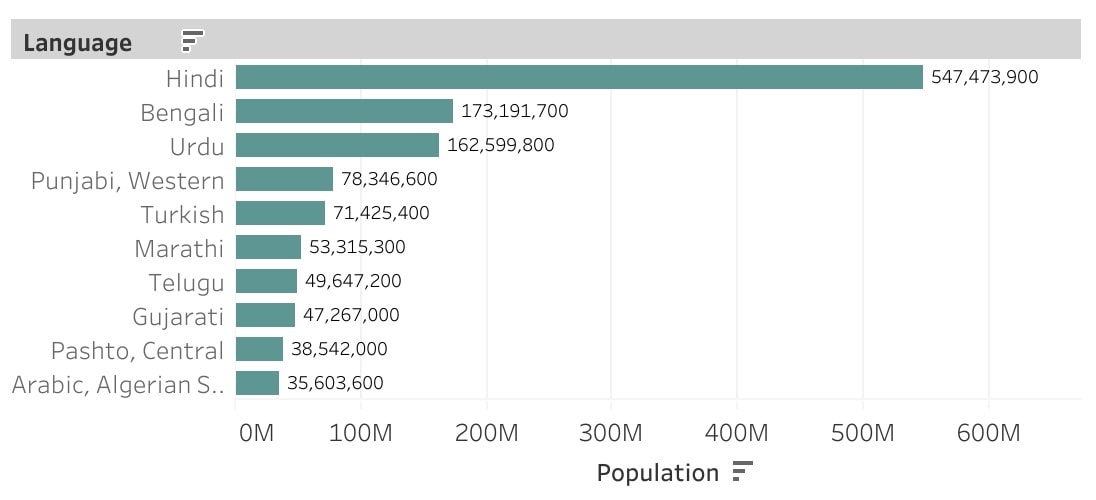
Missionaries
Given the incredible need for the gospel among frontier people groups, you would expect that most Christian missionaries would be going to frontier peoples, right?
Instead, the opposite is happening!
For every 1 missionary that goes to an unreached people group, 30 missionaries go to reached people groups!
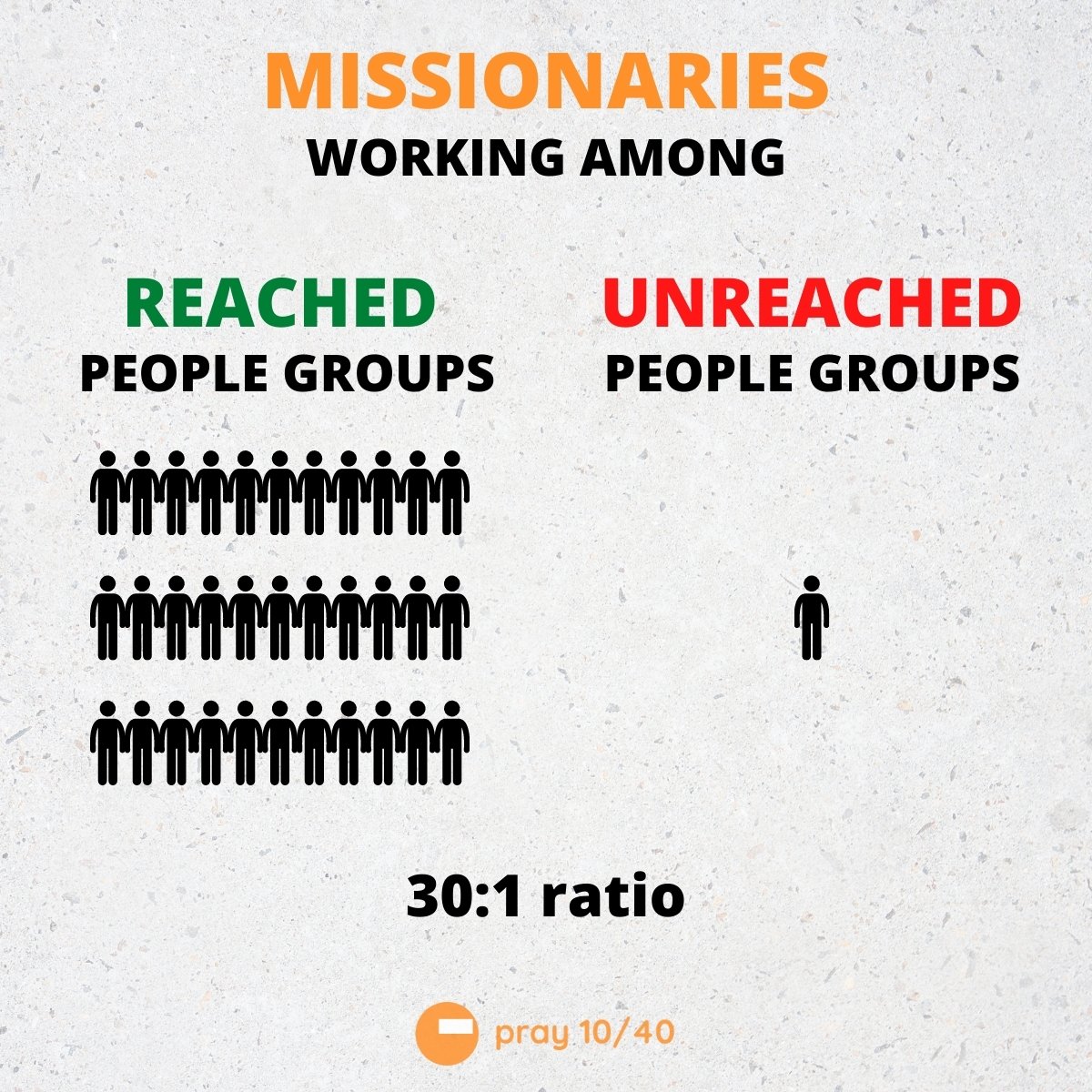
This is called “The Great Imbalance” of missionaries.
Progress
Before you get overwhelmed by the plight of people living among frontier people groups and the lack of missionaries and money going there, we need to take a step back and remember where we came from. We also need to celebrate the incredible gospel progress despite these challenges!
Remember, we serve a God who commanded Gideon to whittle his troops down from 32,000 down to 300 valiant men in Judges 7!
God can do the impossible through a small number of valiant men (and women) through the power of the Holy Spirit!
Jerusalem to Illyricum
Around 2,000 years ago, in Romans 15, Paul says that he had fully proclaimed the gospel of Christ from Jerusalem to Illyricum.
by the power of signs and wonders, through the power of the Spirit of God. So from Jerusalem all the way around to Illyricum, I have fully proclaimed the gospel of Christ. It has always been my ambition to preach the gospel where Christ was not known, so that I would not be building on someone else’s foundation.
– Paul in Romans 15:19-20
From Jerusalem to Illyricum is where Paul went during his three missionary journeys. Illyricum is north of Macedonia in modern day Croatia.

Certainly Paul didn’t mean that he had personally proclaimed the gospel to every person in this region. But he and his co-workers did establish (house) churches throughout this region and leaders had been identified to continue the work.
Then in Romans 15:23-24, Paul goes on to make another astonishing claim
But now that there is no more place for me to work in these regions, and since I have been longing for many years to visit you, I plan to do so when I go to Spain.
The Apostle Paul in Romans 15:23-24
It wasn’t because everyone had received the gospel that Paul didn’t have anymore work to do there. In fact, using modern metrics, many of these people groups and places would probably still have been considered unreached.
The reason there was no more work for Paul from Jerusalem to Illyricum was because his apostolic work had been completed — churches had been established and leaders had been appointed.
Now it was time for Paul to move on to different “frontier places” and “frontier peoples” where there was no church foundation, such as Spain.
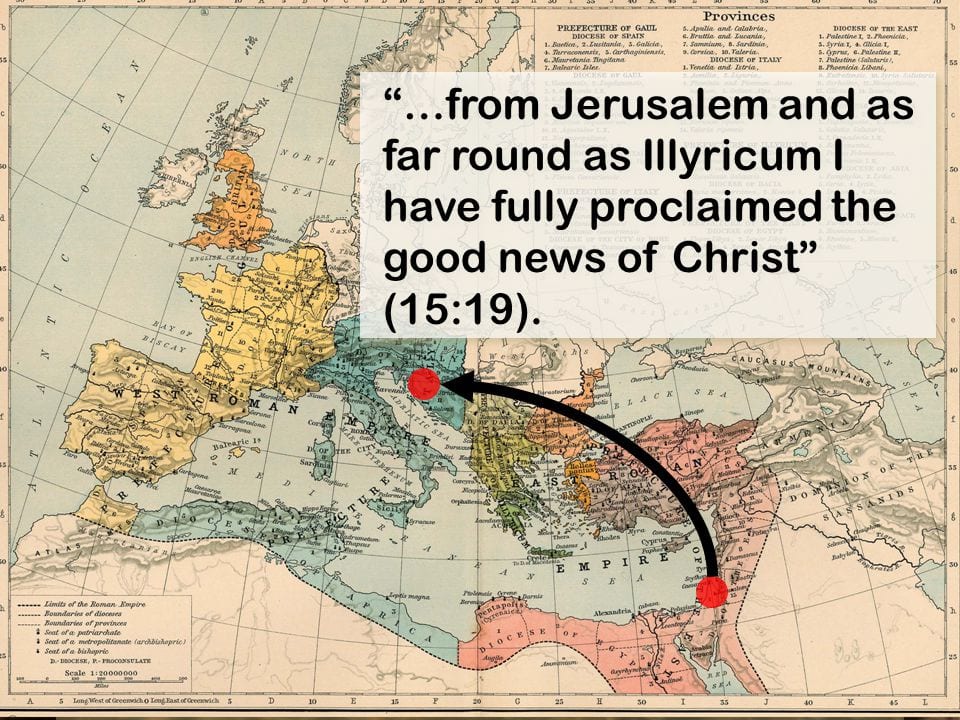
Waves of Modern Missions
Apart from the Moravians in the 1700s, there wasn’t much Christian missions progress until William Carey sparked the 3 Waves of Modern Christian Missions
Wave 1: Coastlands from 1792-1910
Sea travel allowed missionaries to travel to remote coastlands.
Wave 2: Inlands from 1865-1980s
Once the majority of coastland areas had been reached, attention moved to inland areas.
Wave 3: People Groups from 1934 – today
Cameron Townsend, Donald McGavran and Ralph Winter shifted the attention from reaching modern political nation states to the ethnic group “nations” or ethne that Jesus refers to in the Great Commission.
As the attention has shifted from political nations to people group “nations”, incredible progress has been made!
In 1980, 60% of humanity was estimated to live in what are now called frontier people groups.
Today, only 25% lives in frontier people groups.
Could we see 0% of the world living in frontier people groups in the next 50 years?
There are a number of stats that make me believe it will happen even faster!
Bible translation has greatly accelerated.

As of January 2022, Finishing The Task reported that were only 144 unengaged unreached people groups (UUPG) left to be engaged with the gospel by missionaries. [source]
The number of movements throughout the world is greatly accelerating. In 2017, there were around 600 active church planting movements. As of March 2022, 24:14 estimates that there are 1,855 active church planting movements going on around the world.

There have been more Muslims come to Christ in the past 25 years, than the previous 1,400 years combined! [source]
And India is being reached with the gospel at a rapid rate!

Remember, India (as a country) and Islam (as a religion) are home to 97% of the world’s people who are living in frontier peoples!
Get Involved
The three best ways to get involved reaching the world’s remaining frontier people groups are through:
- Informed prayer
- Learning more
- Becoming a cross-cultural missionary
Informed Prayer
“Every great movement of God can be traced to a kneeling figure.”
D.L. Moody
We may be a little biased, but we think the best place for you to sustainably build the habit of intercessory prayer for frontier people groups is right here on Pray1040!
Head on over to our Pray for Frontier People Groups page to sign up to receive weekly educational prayer emails about the 10 largest or 38 largest frontier peoples.

“Slow drip” your learning and prayers for the 38 largest frontier people groups in the world with Pray1040! Receive a new prayer profile each week covering the 38 frontier people groups that have more than 10 million people. Each profile takes 5-10 minutes to pray through.
Prayer Guide
If you prefer a PDF prayer guide to pray through, you can download or print The Thirty One at go31.org.
Podcast
Learn about and pray for each of the 31 largest frontier peoples with the Pray for the 31 podcast!
For Children
Looking to cultivate and awareness of frontier people groups in your children? Indigitous has created a beautiful prayer PDF prayer guide and supplemental podcast about the 31 largest frontier peoples.
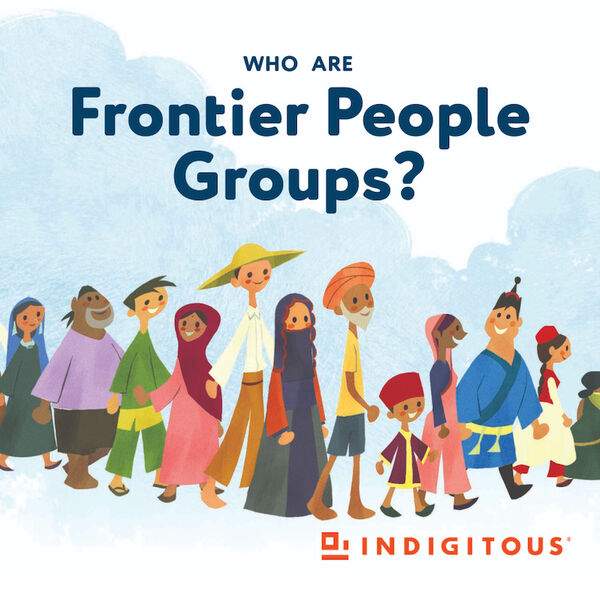
Learn More
Continue your learning journey about frontier peoples by exploring the resources available on frontierpeoples.net. Play around with their interactive map and explore their resource page which includes infographics, videos, PowerPoints, prayer guides and more!
Articles
The Frontier Peoples: Still Waiting to Hear About Jesus (Mission Frontiers)
Introducing Frontier Peoples (Mission Frontiers)
Clarifying the Remaining Frontier Mission Task (International Journal of Frontier Missiology)
Overcoming Frontier People Barriers
Websites
Below are some other websites where you can learn more about frontier peoples and pray for them:
Become A Missionary
Get started on your journey to becoming a cross-cultural missionary to frontier peoples today by going to our Get Involved page and check out the Go and Welcome sections.
FAQ
How many frontier people groups are in the world?
According to Joshua Project, there are 4,971 frontier people groups in the world.
What is the largest frontier people group in the world?
The largest frontier people groups in the world is the Bengali Muslim Shaikh of Bangladesh with 130,300,000 people.
What is the most strategic language to learn to reach frontier people groups?
With almost 550,000,000 native speakers in frontier people groups, Hindi is the most strategic language to learn for reaching the most frontier peoples. Bengali is second with 173,000,000 native speakers and Urdu is third with 163,000,000.
